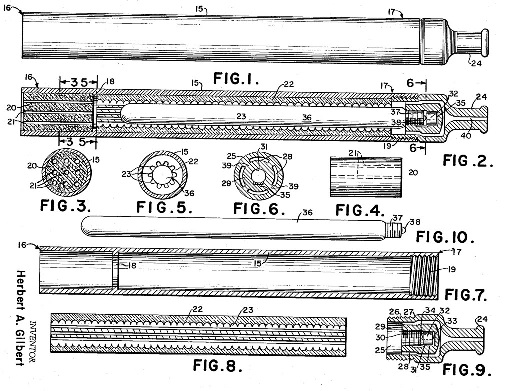Electronic cigarettes deliver the same nicotine as traditional cigarettes but with fewer additives. They offer themselves as an alternative to traditional cigarettes and possibly as an effective nicotine replacement therapy. Being that they are less harmful to our environment, electronic cigarettes are a strong example of how engineers are seeking to reshape our world for the better.
Introduction
Tobacco has been in use as early as 700 AD, but only in the last decade have engineers been able to revolutionize how tobacco is smoked [1]. Traditional tobacco smoking is not only addictive, but it also elevates the user’s risk of developing lung cancer and emphysema. Electronic cigarettes may provide smokers with a new method of kicking the habit and a safer alternative to traditional cigarettes, which are often laden with toxic chemicals like arsenic and cadmium [2]. Beyond the potential of possibly eradicating traditional cigarettes, if not cigarette smoking in general, the use of electronic cigarettes spares the public from the nuisance that is second-hand smoke without exiling smokers from society. From the technology behind electronic cigarettes, to their immediate and future possibilities, this small device is a huge feat in engineering.
History of Tobacco Use
Evidence marks the earliest use of tobacco back to the Maya in 700 AD [1]. Fig. 1 shows a Mayan flask that is believed to have housed tobacco leaves [1]. The earliest known written records of tobacco use come from the time of Christopher Columbus’s exploration of the New World. In 1492, on the island of Hispaniola, Columbus and his crew were first introduced to tobacco by the natives [3]. Within the following decades, tobacco use spread throughout Europe. It eventually reached Asia and Africa during the 1600s as well.
Tobacco use, though far more accepted then than today, has always been an area of controversy. One of the first articles opposing tobacco use came from James I of England in 1604, called “Counterblast to Tobacco” [3]. James described tobacco as being “a custome loathsome to the eye, hateful to the nose, harmful to the brain, [and] dangerous to the lungs” [3]. Other rulers also opposed tobacco use, like Turkey’s ruler from 1623 to 1640, Murad the Cruel. Those who used tobacco under Murad’s rule were liable to be hanged or beheaded [3]. The first scientific anti-smoking movement occurred in Nazi Germany after German researchers discovered a link between smoking and lung cancer [4][5].
Today we hear not only of the dangers of smoking to the user, but also to those around the smoker. This new focus on the danger of environmental tobacco smoke has brought about many laws that have banned smoking not only from bars and restaurants but parks and sidewalks. In some areas smoking is prohibited even in one’s own apartment, including the private balcony [6]. These restrictions have created a segment of society that might feel exiled or disenfranchised, or in the least inconvenienced. With over a billion smokers worldwide, around one in three adults, that’s a lot of people to crowd at the edge of society [7]. But considering tobacco is responsible for six million deaths a year and up to half of all tobacco users die due to tobacco-related illnesses, it is society as a whole that is missing out on all the wasted human potential and losing loved ones [8].
Enter two engineers, not looking to ease the inconvenience of a smoker’s walk to the far end of a parking lot to light up a cigarette but rather to provide a safer alternative to that cigarette—an alternative that would not only allow the smoker to continue smoking with less risk but perhaps even assist the smoker hoping to quit. First released in China in 2004, the electronic cigarette was inspired by hope, loss, and even some early designs from inventor Herbert A. Gilbert, which are pictured in Fig. 2 [11].
Engineering a Dream to Reality
Dr. Sam Han, who holds a doctorate in Mechanical Engineering as well as in Material Engineering, and Hon Lik, who is a pharmacist, are both credited with engineering the first electronic cigarette [9][10]. Both had a dream of helping others quit smoking. Han, a heavy smoker for over forty years, wanted a way to help himself and others quit [9]. Lik, after losing his father to lung cancer, wanted a safer and cleaner way to smoke [10].
Smoke without Fire?
Electronic cigarettes require no flame and work without combustion. Instead of creating smoke they create vapor, similar to a vaporizer or fog machine. No different than smoking a traditional cigarette, the user will inhale and exhale. This entire recreation of smoking a cigarette typically comes in three parts: the battery, the vaporization chamber, and the cartridge [12].
Electronic cigarettes are much heavier than their traditional counterpart. This additional weight comes primarily from the battery that powers the device. These lithium batteries are similar to those found in our cell phones in that they are rechargeable [12]. In many models the battery has a light-emitting diode, or LED, affixed to the front to indicate use and imitate the lit end of a traditional cigarette. This LED will also flash to indicate a dead battery. Attached to the battery is the vaporization chamber.
All of the engineering magic of the electronic cigarette takes place within the vaporization chamber. Liquefied nicotine is converted into vapors, or “smoke”, through the use of an atomizer [12]. An atomizer is a device that breaks a substance down into a fine mist. This is accomplished by use of a heating coil that heats up the liquefied nicotine to convert it into a mist, or vapors. A microprocessor, stored in the chamber, controls this heater as well as the LED light and serves as the brains of the entire device [12]. Due to a loss of efficiency over time, this chamber requires periodic replacement around every three months depending on use. Fig. 3 shows the atomizer and coil as well as the vaporizing chamber. All three parts make up the vaporization chamber as whole. At the end of the device is the cartridge.
Cartridges, which hold the nicotine liquid and serve as the mouthpiece, are attached to the vaporization chamber. Within the cartridge is a wick that has been submersed in the liquefied nicotine. The wick absorbs the liquid, to prevent leaking, and allows the liquid to drip onto the atomizer. The atomizer, when activated, converts the liquid into a vapor [13]. Unlike typical forms of liquid, such as water, the liquefied nicotine is of thicker consistency. These cartridges typically last as long as a traditional pack of cigarettes (twenty cigarettes) but vary depending on brand and individual use.
Electronic cigarettes are available in automatic and manual. In the automatic model, a sensor in the vaporization chamber activates the device when airflow is detected. In the manual, there is a button that must be pressed to activate the device when one inhales. The automatic costs slightly more and has the downside of the device activating when not inhaling due to airflow.
Typically, electronic cigarettes are a one-time purchase with periodic replacement of the vaporization chamber and frequent replacement of the cartridge. A single cartridge can be reused if the user purchases the liquefied nicotine and refills the cartridge him or her self. Disposable electronic cigarettes, which retail for the same price as a pack of premium cigarettes, have also found their way into the e-cigarette market. They work in the same way as a non-disposable cigarette, but they do not allow for the customization of parts or refilling of the cartridge.
So, What’s This Liquid?
The liquid used is primarily propylene glycol, which is approved for use in food by the Food and Drug Administration (FDA) [12]. Vegetable glycerin is also present, which is an organic compound used in food as a sweetener [13]. In addition to those two main ingredients, nicotine and other flavorings may be present.
Consumers may purchase the liquid from a variety of different sellers and manufacturers. Beyond choosing the level of nicotine in the liquid they can choose different flavors as well. Fig. 4 shows a particular flavor as well as packaging. From cherry limeade to Red Bull and even imitations of popular cigarette brands, there are many options. One can even choose to have no nicotine present in the liquid, which is especially helpful for those who wish to quit but want to continue the sensation of “smoking.”
Is This Thing Even Safe?
Murray Laugesen, the head of a study conducted by Health New Zealand, claims that “all pointers so far show the device is safe” [14]. For the user, their study found that each drag released “a few micrograms of water, alcohol, nicotine, PG and flavoring” [14]. Traces of nitrosamines, carcinogens that are found in traditional cigarettes, were also detected, though no more than what is found in nicotine patches [14].
Based on the results of two studies in Greece, Dr. Konstantinos Farsalinos believes that “substituting tobacco with electronic cigarettes may be beneficial to health” [15]. In a study that compared cardiac function between traditional smokers to electronic electronic smokers, those smoking e-cigarettes for a period of seven minutes experienced less of an increase in blood pressure and heart rate than those smoking one traditional cigarette [15]. In another study, lung function was found to be impacted to a lesser degree by the use of an e-cigarette than by the use of a traditional cigarette [15].
In spite of the positive conclusions drawn from such studies, the FDA discovered that some nicotine cartridges contain toxins and some of the same carcinogenic compounds found in traditional cigarettes [17]. In examining a selection of cartridges from two manufacturers, the FDA also found traces of nicotine in cartridges labeled as nicotine-free. Responding to the FDA’s findings, Dr. Brad Rodu, a professor of medicine and an Endowed Chair of Tobacco Harm Reduction Research at the University of Louisville in Kentucky, argues that the FDA detected TSNAs—tobacco-specific nitrosamines—”at about 1 million times lower concentrations than are conceivably related to human health” [18].
Another study from the Boston University School of Public Health that examined the safety of electronic cigarettes found that “few, if any, chemicals at levels detected in electronic cigarettes raise serious health concerns” [16]. Dr. Michael Siegel, head of the study, also warns that “existing research does not warrant a conclusion that electronic cigarettes are safe in absolute terms and further clinical studies are needed” [16].
An Excuse to Smoke?
Electronic cigarettes, in addition to providing a safer alternative to traditional cigarettes, have the potential to help smokers quit entirely as an effective nicotine replacement therapy treatment. Peter Hajek, director of the Tobacco Dependence Research Unit at the Barts and London School of Medicine and Dentistry in the UK, believes “it could have a role in harm reduction and smoking cessation and thus be of public health benefit” [14].
A study from the Boston University School of Public Health found electronic cigarettes to be nearly twice as effective as a nicotine replacement therapy in comparison to nicotine patches or gum [19]. The “study suggests that electronic cigarettes are helping thousands of ex-smokers remain off cigarettes,” said Michael Siegel, the study’s lead author [19]. Siegel specifically mentions how the devices “simulate the smoking experience, which appears to make them effective as a smoking cessation tool” [19].
In Italy, over half of a group of 40 smokers had reduced their use of traditional cigarettes by a minimum of 50 percent [18]. Close to a quarter of those 40 smokers quit smoking entirely [18]. An online survey of smokers found the majority of electronic cigarette users were able to fully replace their traditional cigarettes with the electronic [20]. The survey also found that the smokers’ general health had improved with the use of an electronic cigarette instead of the traditional—Reduced smoker’s cough, a greater ability to exercise, and a heightened sense of smell and taste [20].
In comparison to smokers who attempt to quit by use of nicotine patches or gum, only 8.8% remain smoke-free at the sixth month after quitting smoking with the patch or gum [21]. In fact, the relapse rate of previous smokers is the same for those who use the patch or gum to quit and those who quit cold turkey [22]. The electronic cigarette has a benefit over the patch and gum in that it is more affordable, more accessible (available at convenience stores), and allows the sensation of a relapse without actually relapsing.
While the risks of smoking outweigh any possible benefit, there is hope that engineers might have created a safe, effective device to deliver the benefits of smoking without the risk. In the meantime, those who are smoking traditional cigarettes have a safer alternative as well as a new nicotine replacement therapy to help quit smoking. As for the public at large, electronic cigarettes spare us the watery eyes that James I of England complained about and streets littered with cigarette butts.
Sparing Our Environment
Health concerns aside, electronic cigarettes are better for the environment. Over four trillion cigarette butts litter our world each year [23]. Fig. 5 reminds us all of the toll cigarette butts leave on our environment. Although cigarette butts are biodegradable, that process can take anywhere from one month to three years or longer. Within the butt are chemicals, some toxic and soluble, which can leach off after being exposed to water possibly contaminating our soil and water. Additionally, cigarette butts can be responsible for triggering fires. Electronic cigarettes may not only end the epidemic of our world suffocating in cigarette butts but also reduce waste.
Electronic cigarettes are largely a one-time purchase. Unlike traditional cigarettes that must be repurchased, only the cartridges must be continuously replaced. But even then, the user can reuse his or her cartridge by purchasing the liquid, which further reduces waste. As for the vaporization chamber, the lifetime of that piece can be extended by regular cleaning. In any sense, the cartridge and chamber will not likely be found anywhere but a trash bin when disposed.
Conclusion
Electronic cigarettes are a testimony to the infinite reach of engineering. The electronic cigarette is not only sealing the divide between smoker and non-smoker but is also lessening our impact on the environment. Perhaps society might even have a safer and more affordable means to access the benefits of nicotine all thanks to engineering.








